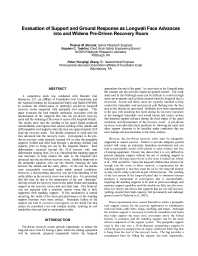Mining Publication: Evaluation of Support and Ground Response as Longwall Face Advances into and Widens Pre-Driven Recovery Room
Original creation date: July 2007
A cooperative study was conducted with Emerald Coal Resources, L.P., an affiliate of Foundation Coal Corporation, and the National Institute for Occupational Safety and Health (NIOSH) to evaluate the effectiveness of (partially) pre-driven longwall recovery rooms supported with pumpable roof supports. This paper evaluates the load transfer mechanics associated with the advancement of the longwall face into the pre-driven recovery room and the widening of the room to recover the longwall shields. The results show that the yielding of the panel fender produced uncontrollable convergence that caused yielding of the shields and stiff pumpable roof supports when the face was approximately 10 ft from the recovery room. The shields continued to yield until the face advanced into the recovery room. Convergence in the predriven recovery room typically reached 6-8 in once the pumpable supports yielded and shed load through a declining residual load capacity prior to being cut out by the longwall shearer. Roof deformations occurred beyond the 32-ft horizon with total deformation ranging from 2 to 4 in, indicating that standing support was necessary to help control the span as the longwall face advanced into the pre-driven recovery room. Stability improved as the pumpable supports were cut out, thereby reducing the span between the shields and the outby pillars. In the end, the shields were successfully recovered under stable ground conditions. However, a disconcerting discovery was the load shedding of the outby pillars as the recovery room was mined into. It is postulated that this may be due to the progression of the rear "abutment" moving toward the recovery room as the panel fender and standing support in the recovery room yield and shed load. This behavior was not expected with a relatively narrow room that is fully supported with standing support. If this mechanism is indeed occurring, the width of the room and performance of the standing support becomes even more critical. Premature failure of the support can lead to excessive convergence on the shield line that cannot be controlled even with modern shields, resulting in roof instabilities that can lead to catastrophic results.
Authors: TM Barczak, SC Tadolini, P Zhang
Conference Paper - July 2007
NIOSHTIC2 Number: 20032435
In: Peng SS, Mark C, Finfinger G, Tadolini S, Khair AW, Heasley K, Luo Y, eds., Proceedings of the 26th International Conference on Ground Control in Mining, July 31 - August 2, 2007, Morgantown, West Virginia, Morgantown, WV: West Virginia University, 2007; :160-172
See Also
- Considerations for Using Roof Monitors in Underground Limestone Mines in the USA
- Guidelines for the Control and Monitoring of Methane Gas on Continuous Mining Operations
- Longwall Shield and Standing Gateroad Support Designs - Is Bigger Better?
- Longwall Shield Recovery Using Mobile Roof Supports
- New Developments with the Coal Mine Roof Rating
- Pumpable Roof Supports: Developing Design Criteria by Measurement of the Ground Reaction Curve
- Pumpable Roof Supports: An Evolution in Longwall Roof Support Technology
- Rock Mass Behavior and Support Response in a Longwall Panel Pre-Driven Recovery Room
- Technology News 481 - Update: Roof Monitoring Safety System for Underground Stone Mines
- Updating the NIOSH Support Technology Optimization Program (STOP) With New Support Technologies and Additional Design Features
- Page last reviewed: 9/21/2012
- Page last updated: 9/21/2012
- Content source: National Institute for Occupational Safety and Health, Mining Program


 ShareCompartir
ShareCompartir
